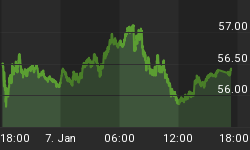Below is an extract from a commentary posted at In a very detailed article at As far as we are concerned there is no question that the $ would strengthen and the $ gold price would weaken if the US experienced genuine deflation. What must be appreciated is that the US$ is weak due to inflation and the effects of inflation. For example, the massive US trade deficit is simply an effect of inflation. Therefore, if the US moved from inflation to deflation then the factors that have been pushing the dollar lower would start to diminish and would, if the deflation persisted, eventually disappear. It is also worth mentioning that the reduction in the foreign demand for US assets during a period of dollar deflation would probably be offset by a surge in the demand for US Government debt. This is because the US Government is an institution with unlimited access to dollars and, hence, an institution that will never be unable to meet its NOMINAL dollar obligations. In other words, under the current monetary system there will never be any DIRECT default risk in US Government debt, just the risk of indirect default via inflation, so during a period of genuine deflation the demand for treasuries would soar. The important question to ask, therefore, is: What is the probability of the US experiencing genuine deflation over the next several years?
As explained repeatedly in TSI commentaries over the past 5 years, we think the probability is close to zero. The reason is that in the unlikely event of a contraction in US household debt -- we say "unlikely" because although it is feared that US consumers are now close to their collective debt limit such fears have emerged during every decade since the 1950s and yet the total debt has invariably continued to expand -- the Fed stands ready, willing and able to monetise anything and everything in order to ensure that the supply of dollars continues to grow. After all, the Fed, not the consumer, is the primary source of inflation (chronic inflation didn't exist in the US before the Federal Reserve was created).
On a side note, whenever we mention our view that the Fed has the power to prevent deflation we always receive a few questions along the lines of "But what about Japan? If a central bank can prevent deflation then why was the BOJ unable to stop the deflation in Japan during the 1990s?"
Sidestepping, for now, the point that Japan did NOT experience deflation during the 1990s, the Japanese chose not to go down the path of massive debt monetisation. Instead, the bad loans were essentially left in place and government spending programs were implemented with the aim of stimulating growth. However, based on the way the monetary authorities have reacted to every economic/financial crisis of the past 15 years there should be little doubt that any future debt problem that poses a serious threat to the US economy will be monetised out of existence. And that the situation will be handled in this way regardless of the adverse consequences for the dollar and long-term economic growth prospects. In any case, we are starting to wonder just how far the of today will have to diverge from Japan of the 1990s in order to bring an end to the idea that the US is following the Japanese path.
In summary, the main point doesn't revolve around whether the dollar will strengthen or weaken IF the US enters a prolonged period of genuine DEFLATION. Instead, it revolves around whether or not the Fed will remain committed to INFLATION. Our view, as you know, is that it will.
*"...the idea is that during a period of intense deflation, American citizens who have managed to amass significant amounts of indebtedness will attempt to reduce their debt by selling their goods or possessions in an attempt to raise cash with which to pay off their debts. This will result in increased demand for dollars as people will tend to hoard cash as the deflationary spiral worsens. In a deflationary environment of falling prices, the purchasing power of the U.S. Dollar will actually increase since falling prices will allow holders of cash to actually obtain more goods for the same amount of money. The claim is that this increased demand for dollars will result in the dollar actually strengthening much to the consternation and surprise of many who are expecting a severe decline in the dollar." From "The Synthetic Short Dollar Theory Weighed in the Balance" by Dan Norcini.
















